
ERIK CRUZ has depended on the jeepney to provide for his family’s daily needs and to send his three children to college.
For almost two decades, he has been traversing the Quiapo Central route, an area bustling with activity from small businesses owners who are also striving to make both ends meet.
During the height of the pandemic, Cruz, now in his 50s, lost his primary source of income because of the mobility curbs imposed by the government. While pandemic-related restrictions have been eased, Cruz is facing what he considers as another threat to his livelihood.
“I was eating with my family when we heard the news. It’s sad because it seems like we will suddenly disappear from the road; how can we earn a living when this is where I get the money for my children’s education?” Cruz, who has yet to recover from the pandemic-induced financial losses, said.
In 2017, the Department of Transportation (DOTr) made headlines when it introduced the Public Utility Vehicle Modernization Program to make public transport “efficient” and “environmentally friendly.” Under the program, public utility vehicles (PUV), including traditional jeepneys aged 15 years or older, will be phased out and replaced by electric-powered or Euro 4 compliant vehicles.
But such a goal does not come cheap. According to the DOTr, a modern jeepney costs P1.4 million to P3 million, depending on the unit, worrying drivers like Cruz who worry about the debt they will incur while complying with the policy.
“I am complaining as a parent who uses a jeepney to send my children to school, then suddenly they will just take it away. Where will we pick ourselves up?” Cruz said.
The modernization program proved to be unpopular among transport groups who fear that it would only result in the displacement of workers in the sector.
In March, various jeepney operators and drivers conducted a transport strike to protest the phaseout of traditional jeepneys and the June 30 deadline to consolidate into cooperatives. The Land Transportation Franchising and Regulatory Board (LTFRB) then agreed to move the deadline to Dec. 31 to give transport workers more time to meet the program’s requirements.
Transport groups launched another transport strike on July 24, the day President Ferdinand Marcos, Jr. delivered his second state of the nation address. The strike, which sought to paralyze public transportation in Metro Manila and nearby areas, lasted for three days.
LTFRB regional director for National Capital Region Zona Tamayo defended the PUV modernization program, saying it would “provide a better commuting experience” and prod the transport industry to “do its role in terms of saving the environment.”
DOTR Undersecretary for Legal Affairs Reinier Yebra sees the modernization program as a way to reduce congestion in highly urbanized areas, provide order and mobility options and generate cost savings.
“Estimated monthly driver income will increase, considering savings from fuel, ending the boundary system, and allowing drivers to take home more earnings within a more decent number of working hours,” Yebra told The Flame.
‘Useless’
To help drivers buy modern jeepney units, the LTFRB will increase the subsidy for affected transport workers from P160,000 to P260,000. Such an adjustment is necessary due to rising prices of fuel and commodities, officials said.
However, some drivers believe the financial aid won’t go that far.

“There are people who say that the LTFRB subsidy…is still useless because (the unit) does not go to us,” Cruz said.
He is referring to the industry consolidation, which is another component of the modernization program.
According to the LTFRB, individual traditional jeepney operators may consolidate into a cooperative until Dec. 31 this year. However, the agency has also clarified that the December deadline is just for consolidation, not the phaseout of traditional jeepneys.
“The deadline is for the consolidation, urging the drivers to come together, consolidate as one, and start the formation as a cooperative in pursuit of the modernization,” LTFRB Chairperson Teofilo Guadiz III said in a Senate hearing last March.
“If they are not consolidated by Dec. 31, they will not be removed because for now, we’re trying to help them consolidate, and we will continue to assist them, seeing to it that no one is left behind. That is my commitment and the commitment of my agency. That is what we intend to do.”
Individual operators who do not have a consolidated juridical entity must form one, and have it accredited by the Office of the Transportation Cooperatives (OTC) or registered with the Securities and Exchange Commission on or before Aug. 31. It should then file its application for franchise consolidation until Oct. 31 to be issued with a provisional authority valid until Dec.31.
Appeals

PISTON national president Mody Floranda said the modernization program should revisit what he described as the “unfair policies” that would only worsen the conditions of small jeepney drivers and operators.
“The cost is lower (with rehabilitated units), reaching only P950,000, if you compare it to the one sold by the government, which reaches P3.3 million. Where are individual operators going to get such a high amount?” Floranda told The Flame.
While Floranda acknowledged that the modernization program would enhance the transport system, he questioned the requirement for transport operators to join cooperatives to ease the costs of compliance. For him, individual franchises will allow more operators to rehabilitate their units instead of purchasing new ones.
PISTON Secretary-General Steve Ranjo said his group is not against the modernization program but wants a better way to execute it.
“We hope that the sentiment of the drivers will be heard because the time given to comply with the requirements for the PUVMP (public utility vehicle modernization program) is not enough. There are many who resist because the operator will be in debt for purchasing the new unit for the modernization program,” Ranjo said.
Marcos has vowed to revisit the jeepney modernization program to ensure that it would not be burdensome to drivers. Ranjo said the government’s dialogue with the transport groups was a significant win for jeepney drivers and operators. However, PISTON vowed to continue to be vigilant against policies disadvantageous to transport workers.
“Our group will keep an eye out. The problem is that if they have time and months to make a decision, we don’t know how long we can wait. We are running out of time,” Ranjo said.
While PISTON is not opposed to the modernization PROGRAM per se, some drivers are hoping that the Marcos administration would reconsider its decision to implement the program.
Randolf Paterna, who has been a driver for more than a decade, believes the PUV modernization program is not practical.
“The new jeeps they are introducing have only a few available units and it is expensive. Also, when the new unit breaks down, it’s hard to find parts because they have to come from another country,” Paterna said.
“Jeep modernization is difficult for our drivers because many will lose their jobs as the new jeepneys they introduced are a little bit more expensive,” he added.
Former jeepney driver Romeo Charvet, who suffered a heat stroke that impaired his speech, appealed to the government to include the needs of jeepney drivers in its priorities.
“I am already old. Even though I still want to work, no one hires me anymore because of my age. What will happen to my family? What will I provide for my family to eat?” he said.
Corporate takeover?
Criticisms against the PUV modernization program are not limited to the perceived burden it will pose to transport workers.
A policy brief by the University of the Philippines Center for Integrative and Development Studies said the program’s provisions and mandated conditions “provide a window of opportunity for the corporate takeover of small-capacity public transportation in the Philippines.” The takeover may be done through forced confiscation and forfeiture of individual franchises and inaccessibility and inadequacy of financial programs, according to the policy brief published last March.
“Corporations may take charge of routes previously serviced by jeepney drivers and operators who could not ‘modernize,’ or by cooperatives bankrupted by loans for the acquisition of modern jeepneys. Only large corporations possess the financial capacity and resources to complete the requirements of the program without significant financial strain,” the research note read.
“This may lead to the further marginalization of jeepney drivers and operators, and the concentration of market control in the hands of corporate entities,” it added.
According to the policy brief, modern jeepneys, which cost around P2.8 million as of this year, will have to be shouldered by jeepney drivers and operators. Even though they would be assembled locally, modern jeepneys are priced high due to the use of imported parts and equipment sourced from huge corporations abroad, it added.

The research note pointed out that costs significantly rose from P1.4 million to P1.6 million in 2018 to P2.5 million to P2.6 million in 2020. In 2023, costs have risen to an estimated P2.8 million while a traditional jeepney ranges from only P200,000 to P400,000, it said.
“A jeepney operator, on average, earns a daily gross income of P2,500 to P3,000. Expenses — fuel, maintenance, and payments for the jeepney driver (typically at P500)— reduce that income. The cost of a modern jeepney is well beyond the price of a traditional jeepney, and greatly exceeds the financial capacity of jeepney drivers and operators,” the policy brief said.
Higher fares, poorer service
The policy brief argued that the structured loan programs through the Development Bank of the Philippines and the Land Bank of the Philippines are insufficient given the economic realities of jeepney drivers and operators.
“Subsidies offered to the jeepney drivers and operators start at P80,000 and later (increase) to P160,000. These subsidies only cover around five percent of the total cost of a modern jeepney in 2023,” it said.
“Access to these programs are restricted to cooperatives who have obtained a franchise from the LTFRB.”
The policy brief noted that under the PUV modernization program, jeepney drivers and operators must first surrender their individual franchise or provisional authority and consolidate them into a single franchise by registering with the Cooperative Development Authority and getting accreditation from the OTC to be registered with the LTFRB and avail of the loans. The cooperative or corporations under the program must have a minimum number of 15 modern jeepneys operating on a particular route, it added.
“Jeepney drivers and operators face significant challenges in gaining access to the loan programs due to the consolidated franchise being a critical prerequisite,” the research note said.
According to the policy brief, cooperatives must acquire their own garage and a local public transport route plan must be prepared by local governments before the LTFRB can issue a franchise.
“Cooperatives also incur additional expenses through franchise consolidation fees required by the OTC. These fees amount to P300,000 for their consolidation, plus an additional charge of P20,000 per modern jeepney unit,” it said.
The research note noted that the jeepney drivers’ and operators’ fear of losing their livelihood is shared by the thousands of other workers whose livelihood is similarly tied to the jeepney industry.
“Moreover, in the process of forcibly replacing traditional jeepneys with modern ones, they will be overwhelmed by unmanageable costs, potentially leading to insurmountable debt,” it added.
The policy brief also warned that commuters would also be affected by the efforts to modernize jeepneys since cooperatives would need to generate higher daily earnings to cover the high acquisition costs of the modern jeepney. Cooperatives also have to shoulder the additional costs associated with the modernization program, including land purchase, garage construction, consolidation fees, and repair and maintenance expenses.
“For a modern jeepney that is valued at P2.5 million, a daily income of P6,899 is necessary to offset the cost of modern jeepneys. In order to cover the acquisition costs, fares may reach as high as P34 for a modern jeepney with 200 passengers a day,” the policy brief said.
“The privatization of public transport frequently leads to higher fares for commuters…and poorer service, as observed in the case of the privatization of the country’s train system,” it added.
‘The goal is for everyone to upgrade’
Despite the concerns raised by some transport groups, Tamayo said the PUV modernization program would be “institutionalized and implemented.”

“The program wasn’t conceptualized overnight and it’s really based on a study and its goal is for everyone to upgrade,” she said.
Tamayo claimed that since its inception in 2017, more than 60% of operators nationwide had embraced the program. Many have modernized their jeepneys and run their routes as a group through a “corporation or cooperatives,” she added.
Tamayo also clarified that the idea of changing the units is just one component of the whole, and that the government is still trying to make the stakeholders understand the entire program.
‘The continuous dialogue is one of the steps for us to let the stakeholders understand the concept of the PUVMP. The whole PUVMP have several steps. It does not consist of just one component that will require you to replace your vehicle,” the LTFRB official said.
“The first step is the consolidation process wherein we will strengthen the stakeholders on how to do their business. This is what we are saying that they should be together by June 30 but we moved it to December. All operators must join a consolidated entity by yearend.”
Contrary to the criticisms posted on social media, Tamayo said there is no effort to prevent jeepney drivers from retaining the iconic look of the traditional jeepneys as long as they comply with standards.
Yebra emphasized that the Dec. 31 deadline is only for the “consolidation in pursuit of modernization, and not phaseout of existing PUVs.”
“(Furthermore), DOTr and LTFRB are looking into extending (the) franchise of old traditional jeepneys to ensure that there will be enough supply of PUVs to serve the public,” he added.
Yebra disclosed that the DOTr is also asking the LTFRB to ease the requirements for the PUV modernization program.
“The government will also revisit and recalibrate existing policies to ensure that strategies do not veer away from program’s objectives, especially on improving welfare of drivers, operators, and commuters,” Yebra said.
Longer transition period sought
UST Economics Department Chair Assoc. Prof. Carlos Manapat said enforcing the PUV modernization program without a transition period would cause inconvenience among commuters and decrease the income of the transport industry.
“If there is no transition period, there is a negative impact because of less vehicles, people would have a difficult time in going to their places of work and income of the transport industry will go down,” Manapat said.
“Its impact would be negative because many drivers are at risk of losing a livelihood and many in the workers wouldn’t be able to reach their workplaces in the situation when plying jeepneys will be minimized,” he said.
UST political science professor Jazztin Jairum Manalo noted that the push for better public transportation is one of the steps needed for the Philippines to reach the status of a developed state. He acknowledged that progress does not happen overnight and that the implementation of the PUV modernization program does not guarantee success in terms of becoming a developed country.
IBON Foundation Executive Director Sonny Africa said the main concern is not time, but resources.
“If the resources are not there, no matter how much time they (government) will give (for the consolidation) will not be enough—even if it’s two years, five years, or ten years—because they (jeepney drivers and operators) will not be able to afford the units,” he said.
Africa expressed concern that the “grandmotherhood objective” of the program is to cover up the “worsening corporatization of small jeepney operators.”
“Basically, you’re having small drivers and operators, you’re beholding them to cooperatives but there’s actually more corporate interest because you’re putting them (in) a situation where they’ll be in exploitative relations with the owners of the jeepney and the big operators,” he said.
Not ready

Instead of resorting to a corporative system that is “too expensive for ordinary Filipinos,” the government has to step in and subsidize public transportation to make it clean, safe, and affordable, Africa said.
“The better route is for the government to embrace building a public transport system that is publicly centered on a nationalized mass transport,” he added.
While the government has repeatedly cited the benefits of the PUV modernization program, some drivers are not yet ready to embrace it.
Instead of phasing out traditional jeepneys, Cruz said the government should assist drivers like him by lending them vehicle parts and providing financial aid they can use to upgrade their units.
“If they really want, they can lend us an engine so we can improve our unit if the problem is just smoke,” he said.
Paterna urged the government to prolong the grace period for the compliance to a few more years.
“If they [government] want modernization, they should first let the drivers accumulate enough money. Everyone wants to improve, but if it’s sudden, it will be more like a burden to us,” he said. F – with reports from Joss Gabriel Oliveros



